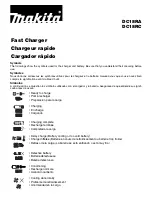
[email protected] | W W W.GLCHARGE.COM
PAGE: 32 // 46
G LCH A RG E D.O.O.
PAGE: 33 // 46
7
SI
EN
Pull the charging cable through the leading
line, bringing the housing towards the back of
the charging station. Place the tie on the inside
of the charging station, above the inlet line.
The tie serves to prevent the charging cable
from being pulled out of the charging station.
Finally, tighten the leading line behind the
charging cable.
Povlecite polnilni kabel skozi uvodnico tako, da
ohišje približate zadnji strani polnilnice. Vezico
namestite na notranjo stran polnilnice nad
uvodnico. Vezica služi varovanju pred potegom
polnilnega kabla iz polnilne postaje. Na koncu
ustrezno privijte uvodnico za polnilni kabel.
DE
Ziehen Sie das Ladekabel durch die
Durchführung, indem Sie das Gehäuse an
die Rückseite der Ladestation annähern.
Bringen Sie den Kabelbinder an die
innere Seite der Ladestation oberhalb der
Durchführung an. Der Kabelbinder dient dem
zusätzlichen Schutz gegen gewaltsames
Ziehen/Herausziehen des Ladekabels. Zum
Schluss die Ladekabelverschraubung richtig
festziehen.
8
SI
EN
DE
Connect the 2-pole green SAURO connector that
connects the LED light to the power supply.
Priključite 2-polni zeleni SAURO konektor, ki
povezuje LED osvetlitev z napajalnikom.
Schließen Sie den 2-poligen grünen SAURO-
Steckverbinder an, der die LED-Beleuchtung
mit dem Stromnetz verbindet.
SI
EN
DE
RFID CONFIGURATION:
To start charging with the
RFID card, the user should first plug the charging
station cable into the car. After the plug-in, the RFID
card should be pressed to the designed area on
the charging stations. The ‘beep’ signalize that the
charging has begun. To stop the charging process,
the user once again presses the card to the
designed area on the charging station. The ‘beep’
signalizes the end of the charging process and the
cable can be pulled out.
DLM SETTING:
The DLM circuit includes various so-
called ‘DIP’ switches, which can be set according to
the connection fuses on the facility. The individual
setting can be made by moving each ‘DIP’ switch to
the upper position.
In the case of a facility with 3 x 25A main fuses,
the third ‘DIP’ switch is selected and moved to the
second position. ‘DIP’ switches are marked on the
circuit diagram; each ‘DIP’ switch is suitable for
standard connection rating on facilities – 16, 20, 25,
35A.
For the connection of the energy meter and the
charging station see the enclosed diagrams
(Diagram 1: GL Charge DLM 1; Diagram 2: GL Charge
DLM 2). We must use only one twisted pair (one pair
of the UTP cable wires, e.g. orange, white-orange)
to avoid interference with RS-485 communication.
The user should consider the correct choice of
poles A and B (marked on the DLM diagram, on the
energy meter and the charging station on the DLM
module).
RFID KONFIGURACIJA:
Z začetek polnjenja z
RFID kartico, uporabnik najprej priklopi kabel
polnilne postaje v avto. Po priklopu na označeno
mesto polnilne postaje prisloni RFID kartico, po
potrditvenemu pisku polnilna postaja prične s
polnjenjem. Za prenehanje polnjenja uporabnik
ponovno prisloni kartico na označeno mesto,
postaja ponovno zapiska in uporabnik lahko izvleče
polnilni kabel.
NASTAVITEV DLM:
Na DLM vezju so razporejeni
različna t.i. ‘DIP’ stikala, ki jih nastavimo glede na
priklopne varovalke objekta. Posamezno nastavitev
uporabnik izbere tako, da posamezni ‘DIP’ prestavi
na zgornjo pozicijo.
V primeru hiše z varovalkami 3 x 25A se izbere
tretje ‘DIP’ stikalo in se ga prestavi v drugo pozicijo.
Na vezju so primerno označena ‘DIP’ stikala,
posamezno ‘DIP’ stikalo je primerno za standardne
priključne moči na objektih – 16, 20, 25, 35A.
Za povezavo med števci in polnilno postajo sta
priloženi shemi (Shema 1: GL Charge DLM 1; Shema
2: GL Charge DLM 2). Potrebno je paziti, da se
uporabi le ena parica (en par žic UTP kabla, npr.
oranžna, belo oranžna), da ne prihaja do motenj
pri komunikaciji RS-485. Uporabnik naj upošteva
pravilno izbiro polov A in B (označeno na DLM shemi,
na števcu in v polnilni postaji na DLM modulu).
RFID-KONFIGURATION:
Für den Beginn des
Ladens mit der RFID-Karte muss der Benutzer
zuerst das Anschlusskabel der Ladestation am
Fahrzeug anschließen. Nach dem Anschließen
muss er die RFID-Karte an der markierten Stelle
der Ladestation anlegen. Nach der Bestätigung
mit einem Piepton beginnt die Ladestation mit dem
Aufladen. Zum Beenden des Ladevorgangs lehnt
der Nutzer die Karte erneut an die gekennzeichnete
Stelle. Nachdem die Ladestation erneut piept, kann
der Nutzer das Ladekabel herausziehen.
DLM-EINSTELLUNG:
An der DLM-Schaltung
sind verschiedene „DIP-Schalter“ angeordnet,
die im Hinblick auf die Anschlusssicherungen des
Gebäudes entsprechend eingestellt werden. Die
einzelne Einstellung wird so ausgewählt, dass Sie
den einzelnen DIP in die obere Position bringen.
Ein Haus mit der nachfolgenden Hauptsicherung:
3x25 A – der 3. DIP-Schalter wird ausgewählt und in
die zweite Position gebracht (an der Schaltung sind
die DIP-Schalter entsprechend gekennzeichnet;
der einzelne DIP-Schalter eignet sich für die
Standard-Anschlussleistung an Gebäuden – 16, 20,
25, 35A).
Für die Verbindung zwischen Metro Energy und
Ladestation sind die Schemen beigelegt (Schema
DLM1: GL Charge DLM 1, Schema 2: GL Charge
DLM 2). Achten Sie darauf, dass nur ein Kabel
mit verdrillten Doppeladern verwendet wird (1
Drahtpaar vom UTP-Kabel, z. B. orange, weiß-
orange), damit es bei der Kommunikation RS-485
zu keinen Störungen kommt. Beachten Sie auch die
richtige Auswahl der (auf dem DLM-Schema und
auf der Ladestation am Schalter gekennzeichneten)
Pole A und B.
Installation to the pre-prepared site
02
Installation to the pre-prepared site
02








































